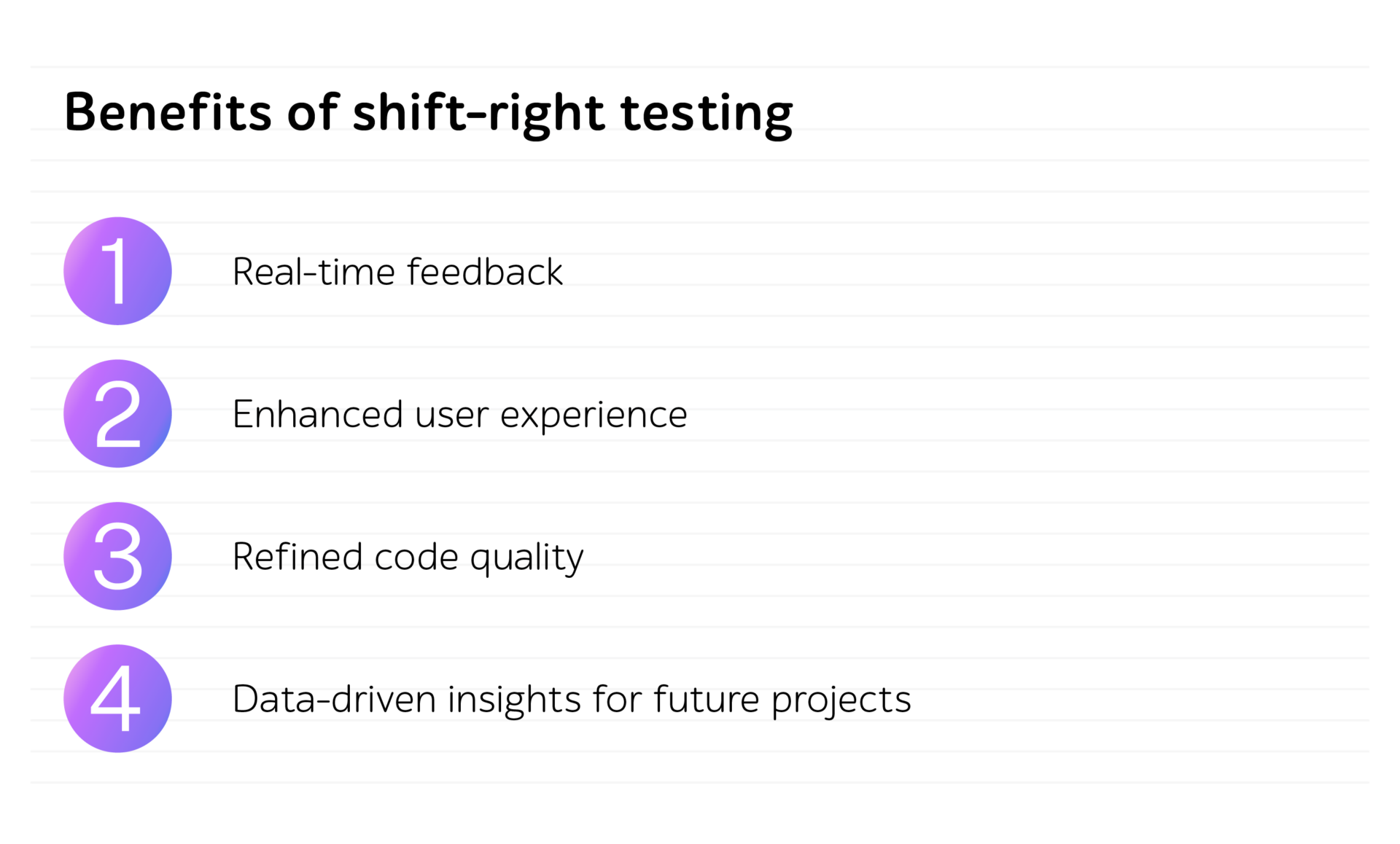
Embracing shift-right testing to enhance software quality through real-world insights
Nowadays, relying on traditional testing methodologies alone isn’t enough to ensure the flawless operation of software products.
Shift-right testing (SRT) has emerged as a compelling strategy to improve the quality of IT solutions while meeting ever-evolving user needs. It has become a useful addition to conventional testing approaches, providing a more comprehensive and user-focused testing strategy.
In this article, we’ll delve into the essence of shift-right testing, explore its benefits, and explain why it’s essential for businesses.
The concept of shift-right testing
SRT represents a departure from conventional testing practices and occurs after deployment. Unlike traditional testing approaches that focus primarily on pre-deployment phases, SRT embraces the idea of gathering real-world insights from actual users and environments to enhance software quality and inspire ideas for new functionalities that cover actual user patterns and needs. For instance, companies can try out releasing new software upgrades by engaging a group of previously chosen users to collect insights into their first impressions and areas for further improvement.
Thus, companies can monitor and enhance software stability, performance, and usability as well as gain access to invaluable feedback that can facilitate better decision-making processes, identify potential software issues, and drive enhancements.
Benefits of shift-right testing
Let’s look closer at the advantages businesses reap when they utilize SRT:
- Real-time feedback
SRT enables companies to gather insights from end-users, helping evaluate software behavior under real-world conditions. This feedback loop assists in identifying all arising defects, leading to improved product quality and boosted customer satisfaction. With SRT, companies can also provide a small subset of users access to a new feature or update to test before its full release, allowing them to detect potential flaws and make informed decisions on its refinement.
- Enhanced user experience
Testing in production allows organizations to prioritize enhancements based on actual user preferences. This iterative approach helps ensure high software reliability and security while making the app more intuitive and user-friendly.
By incorporating UX considerations into the QA workflows, businesses can refine user interfaces, streamline workflows, and optimize interactions, ultimately delivering a seamless and engaging user experience.
- Refined code quality
Incorporating testing into the production environment allows experts to validate the robustness of their code in real-world scenarios. By exposing code to actual clients’ interactions and usage patterns, they can check code performance under various conditions.
Additionally, the iterative nature of SRT encourages companies to adopt best practices and coding standards, leading to cleaner and more maintainable codebases. As developers gain visibility into how their code operates in production, they are incentivized to write functional, scalable, and efficient code.
What’s more, when project teams regularly monitor software behavior and analyze opportunities for optimization during the accretion of new features, they have a higher chance to reach better software performance levels and establish a culture of continuous improvement.
- Data-driven insights for new features and future projects
Shift-right testing provides teams with a wealth of data regarding user behavior, preferences, and interactions with the software. This information serves as a treasure trove of insights that can allow teams to identify trends, patterns, and areas for improvement.
By understanding what resonates with customers and what doesn’t, specialists create specific development and test design documents that are more credible and cater to the expectations of their target audience. As a result, they foster trust and confidence among clients.

Top 3 reasons why businesses should adopt shift-right testing
Let’s explore the key reasons why companies need shift-right testing.
Reason 1. Test in the production environment
Simulated environments often lack the complexity and variability of real environments, rendering emulated QA activities insufficient.
By conducting continuous software monitoring in production, organizations can validate software functioning under real-world conditions and find problems that weren’t detected during earlier testing phases, ensuring seamless operation regardless of fluctuations in user traffic or system load.
This approach allows businesses to uncover potential issues related to scalability, resource utilization, production operation, and environmental dependencies that may only manifest in the actual environments, thereby minimizing the risk of post-deployment failures and disruptions.
Reason 2. Check software based on real-world user experience
Traditional testing methodologies often rely on synthetic data and scripted scenarios, failing to capture the full spectrum of user behaviors.
For instance, a social media platform may face varying customer engagement patterns depending on several factors: time of day, geographical location, or device type. By conducting SRT, enterprises can observe how clients interact with their IT solutions in real scenarios, gaining valuable insights into user preferences and their pain points.
This helps specialists better understand end users while optimizing critical app features, enhancing usability, and meeting the diverse needs of their target audience, ultimately driving user loyalty.
Reason 3. Identify resilience of the system
SRT empowers organizations to identify and mitigate potential issues before they escalate into critical failures, safeguarding the integrity and reliability of their software. For that, QA engineers continuously monitor logs on diverse errors, performance metrics, response times, user interactions statistics, and server health.
Let’s take an eCommerce platform as an example. It may experience sudden spikes in user traffic during promotional events or holiday seasons, leading to system crashes. By predicting such cases in production with the help of monitoring tools and analysis of previous system operation, organizations can quickly assess the resilience of their IT product infrastructure and implement preventive measures to mitigate risks. Thus, experts identify scalability bottlenecks and fortify system resilience, ensuring uninterrupted service delivery and minimizing the impact of unforeseen events on end users.
Pivotal aspects to focus on during SRT
Finally, let’s consider the most valuable techniques to ensure the high effectiveness of this testing practice.
- Monitor production
With continuous software supervision in the production environment, project teams can expose bottlenecks (e.g. performance monitoring, error tracking, user behavior analysis) that might not be evident during previous quality control phases, as well as monitor resource utilization. These actions help optimize performance and lower operational costs.
- Analyze logs
Examining production system logs allows project teams and QA specialists to obtain beneficial and detailed data on inappropriate software behavior, and quickly solve arising issues. It also helps better understand user journeys, learn what functionality the target audience uses most often, identify areas for improvement in their experience, and improve decision-making regarding new features.
- Test resilience
QA specialists simulate controlled chaotic conditions in the production environment to find faults in the software ability to cope with unexpected disruptions, such as server failures or high traffic loads, and remain operable in the long run. Thus, it’s possible to deliver highly robust IT products with strong recovery mechanisms.
- Conduct A/B testing
This QA activity provides excellent opportunities to try out various versions of the application in the production environment to see which of them will be better accepted by end users. With this helpful information, testing teams can enhance their decision-making capabilities, shape long-term product strategies, and cater to diversified user segments.
- Apply feature toggles
This technique allows project teams to accurately control the release of new functionalities in the production environment, test them live, ensure they are invisible to a portion of the target audience during quality assurance, and minimize the risks of affecting the regular operations of end users.
- Work with feedback
Within SRT, user perception of the software is a powerful aspect that directly influences IT product success. Therefore, it is crucial for companies to regularly gather and analyze feedback to continuously improve quality, innovate software products, boost customer satisfaction, and turn end users into brand advocates.
In a nutshell
The adoption of SRT represents a valuable addition to traditional QA approaches, providing organizations with a more comprehensive and user-focused testing strategy.
SRT serves several goals — it allows companies to test IT products in the production environment, check apps based on real-world user experience, and identify worst-case scenarios.
With SRT, they get tangible benefits, including real-time feedback, enhanced user experience, refined code quality, and data-driven insights for new features and future projects.
To ensure SRT effectiveness, companies can stick to regular monitoring, log analysis, resilience and A/B testing, use feature toggles, and collect user feedback.
Contact a1qa’s experts to get support in leveraging shift-right testing principles.








